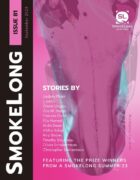The first thing that jumped out at me when I read your beautiful story is the use the second person. I found the usage both affective and effective. I was pulled into the story with immediacy, I was able to experience the relationship and the memories. Did you intend to write this in the second person or did the story evolve into this style?
I started drafting the piece in second person, and that is where it stayed. It was a new approach for me. Second-person stories often require more effort on the part of the reader to suspend disbelief, and because they aren’t as common as first or third person stories, the artifices of perspective are more difficult to conceal. This is changing, I think. Readers, at least of literary genres, are growing more accustomed to it, which isn’t all that surprising. Second person is very common, for example, in song lyrics and advertisements. Skimming social media, driving past a billboard, listening to an AI-curated playlist—implicit in all of these is a direct address: Hey, you. Pay attention.
Your story has the startling image of the father’s ponytail, which forms the crux of the story. The reader can visualize the dark, shiny hair, the red rubber band holding it together. What does the hair signify to you about the father? How does the ponytail determine or direct the relationship between the narrator and the father?
In The Situation and The Story, Vivian Gornick writes: “The situation is the context or circumstance, sometimes the plot; the story is the emotional experience that preoccupies the writer: the insight, the wisdom, the thing one has come to say.” She was writing about personal narrative, but the distinction between story and situation is relevant in fiction, too, especially in flash. In compressed forms, it isn’t often possible to illuminate an emotional experience through a complex plot or extended descriptive passages. This is where imagery can come in.
I hope that readers can come away with different interpretations of what the ponytail signifies. For me, it is about the expectations that parents and children have for one another, and how those expectations change as we age. The father in my story has given up trying to connect with his child, whose desires and values he cannot comprehend. Instead of trying to bridge the gap, he clings to the past, to an idealized version of the both of them, and in doing so, erases them both. The ponytail, at least, is still recognizable to him. It is something he made all on his own. Something that will never challenge him to grow.
The other fascinating thing about the story is how you cover time in such a short space. We get images of a young boy, followed by that of an older boy who comforts his father, then there’s the description of the father himself whose hair thins and grays towards the end of the story. Did you decide to use this compression technique or did the story start much larger and then get distilled into two paragraphs ?
Unlike most of my stories, which usually go through dozens of iterations, this one emerged pretty much as is. I had two images in mind, the mustache and the ponytail. It seemed natural to divide the story into two parts, like a diptych, with each of those images at the center. I wasn’t conscious of using this form as way of compressing time, but it certainly does have that effect.
It takes maturity to understand that parents can be flawed. Do you think your narrator accepted the father, shortcomings and all, as the years went on? Did watching the father’s attachment to his ponytail allow the son to soften toward the father?
Fatherhood is the main preoccupation in my work lately. I’m older now than my father was when I was born, and this has raised all sorts of interesting and difficult questions and feelings. I’m also gay, childless, and wondering if I’ll ever raise children of my own. I’m currently exploring these ideas through both fiction and nonfiction, and there is a lot of cross-pollination.
All this is to say that my narrator has tried their best to find compassion and acceptance for their father, flaws and all. This effort is a painful one, but it has made the narrator more loving and forgiving for those who rely on them for such things.
I feel like that there is much more to this relationship. Do you see this as a series of stories based on this particular father and son? Or the father reappearing as you explore other familial relationships?
One can read “Ponytail” as a letter to the narrator’s younger self, and there is certainly a lot more for the narrator to share, a great deal more wisdom to impart. However, I don’t really see this story as part of a series. It is more of an attempt to do something different with the subjects currently of interest to me. Fatherhood, queerness, and aging to name a few. I like tackling these vast subjects in flash because it forces me examine them more closely, isolate the dimensions I find most interesting, and hopefully convince readers to care about them, too.



 The core workshop of SmokeLong Fitness is all in writing, so you can take part from anywhere at anytime. We are excited about creating a supportive, consistent and structured environment for flash writers to work on their craft in a community. We are thrilled and proud to say that our workshop participants have won, placed, or been listed in every major flash competition. Community works.
The core workshop of SmokeLong Fitness is all in writing, so you can take part from anywhere at anytime. We are excited about creating a supportive, consistent and structured environment for flash writers to work on their craft in a community. We are thrilled and proud to say that our workshop participants have won, placed, or been listed in every major flash competition. Community works.